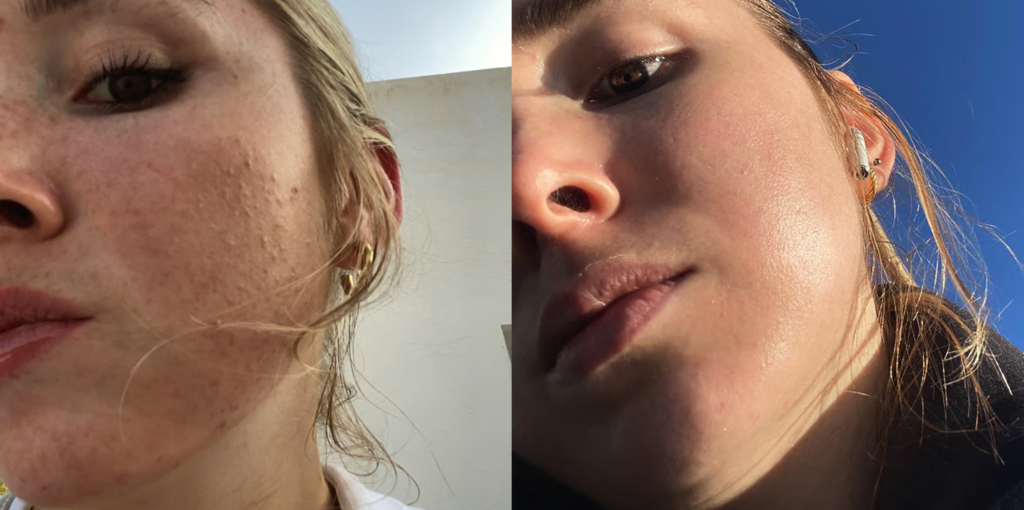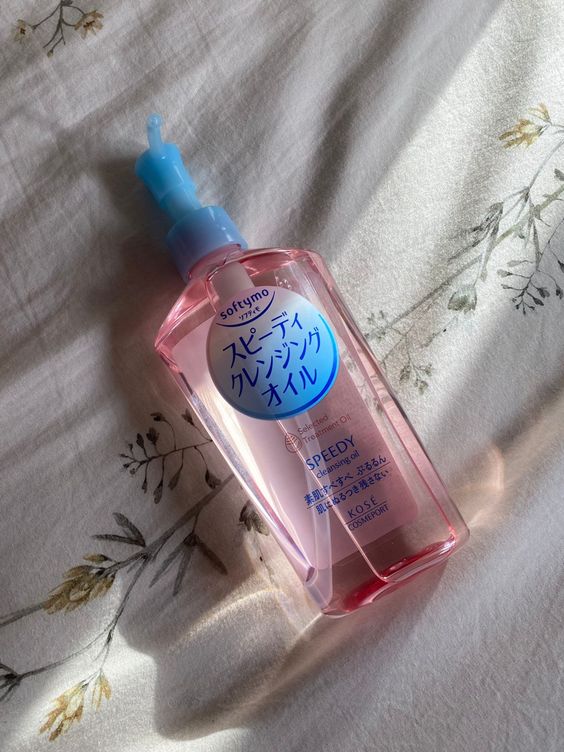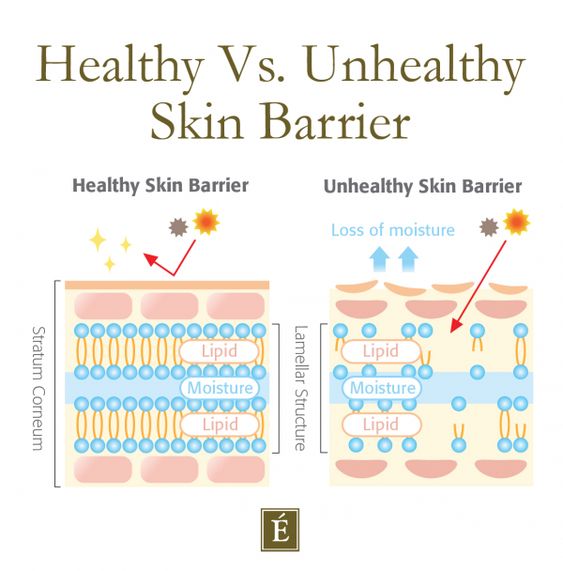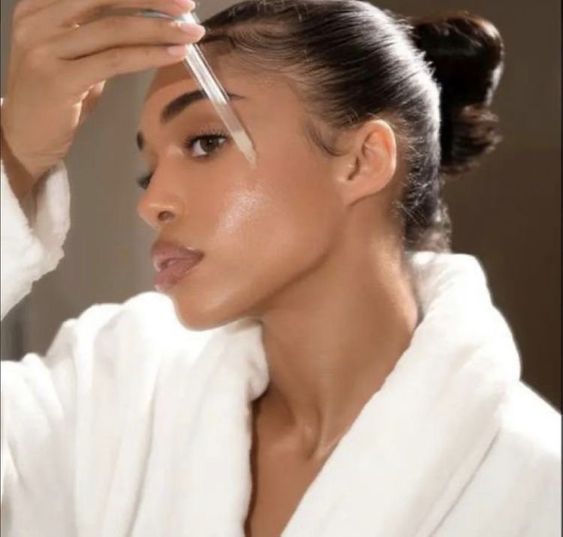This site contains affiliate links. I may earn a small commission, at no extra cost to you.
This post shows you how to get rid of clogged pores on your face, chin and forehead, as well as four skincare mistakes to avoid when treating clogged pores.
Clogged pores aren’t considered a ‘medical’ problem, but when you’re not happy with the way your skin looks it can be really affect your confidence. In the photo below, you can see my skin before and after treating my clogged pores and skin texture.

What are clogged pores?
Let’s start with the basics and understand what clogged pores on the face are. Why do we have skin texture in the first place? It’s good to know what’s going on before we can begin to get rid of clogged pores. Essentially, clogged pores are essentially lot of sebum (oil from your skin) and dead skin cells getting trapped in the pore.
There are few reasons this can happen:
- Not cleansing or double cleansing properly. If you aren’t cleansing your face effectively you’ll leave leave dirt, makeup and SPF in your pores.
- Using pore clogging products. If you use a product that clogs your pores, you won’t be able to avoid getting bumpy skin texture in the long run. We’ll do a whole other section on pore clogging ingredients later. The most common culprits are SPF and moisturiser, but it can be different for everyone.
- Dirty makeup brushes can re-introduce bacteria to the skin, which is never helpful for acne!
- The same goes with damp or re-used face cloths and pillows. I like to buy a few and change mine daily.
- Too little exfoliation or under use of a retinoid. You don’t have to use a retinoid or exfoliate (a retinoid is not an exfoliant) but to have super smooth skin it’s often a requirement.
- Similarly overusing an exfoliant can cause bumpy skin, because it can damage your skin barrier and allow extra bacteria in. This makes it impossible to get rid of clogged pores.
We’ll talk more on all of these in our skincare mistakes to avoid for clogged pores section later.
How to get rid of clogged pores on the face
In order to get rid of clogged pores, here are five steps you need to take. They are the same steps I used to get my results in the photo above!
1. Double cleanse every evening

Some will say that double cleansing isn’t necessary for everyone, but if you’re prone to clogged pores I personally believe it is. Knowing how to double cleanse effectively is very important to getting rid of clogged pores, so I wrote a complete guide to double cleansing.
It include things like:
- Should you double cleanse in the morning
- How to double cleanse
- Which double cleanse products to use
- The best oil cleansers for acne
- Which skin types should double cleanse (oily, dry or combination)
- My favourite skincare accessories to double cleanse (the fun part!)
2. Identify and remove pore clogging SPF and moisturiser

SPF and moisturiser tend to be the two most pore clogging products in someone’s routine, on average. This isn’t to say that that is what’s causing your clogged pores, but it often is. Usually, it’s a combination of all of these post points, which is why I recommend addressing all of them!
This is where things get tough: pore clogging ingredients and skincare ingredient checker websites will not be able to tell you if a product is clogging your pores. If you want to know more on why, I wrote a post on skincare ingredient checker websites.
You will have to experiment and it may take some time, but just know that the reason a lot of people have clogged pores is because one or a few of their products is causing it. Even the term ‘non comedogenic‘ is fundamentally flawed. It is an unregulated term and therefore any brand can call their product non comedogenic. I know I know, I wish it were that easy to tell which might be clogging you.
I am going to write a longer post on this soon, but for now you can view my Linktree for skincare recommendations that are unlikely to clog your pores for ‘safer’ options.
3. Use a retinoid to treat clogged pores

There are lots of skincare products and actives around that claim they’ll ‘smooth skin’ and unclog pores, but which ones are the most effective? Sometimes it can be overwhelming.
When I was learning how to get rid of my clogged pores, I had to decide which skincare actives to use. There are two that kept coming up: salicylic acid and retinoids.
Salicylic acid has worked for so many people, but it made my dry skin SO dry and flaky. I had tried it so many times and I hated it – especially the Paula’s Choice 2% BHA which everyone loves! I decided to try out a retinoid, and I have never looked back.
Here are the retinoid benefits that many other actives don’t have:
- Retinoids are the most effective topical treatment for anti-ageing, alongside SPF
- They can be used from teenage to old age
- Retinoids unclog pores and keep them unclogged, with continued use
- They stimulate collagen production and reduce fine lines (the lines on my forehead were more noticeable when I was 23, I’m now 28!)
- They improve the appearance of scars and hyperpigmentation
- They are the go-to topical treatment for acne by dermatologists
- Retinoids can reduce oil production over time – your oily skin can literally become less oily!
I could literally go on… if you follow me on TikTok you’ll probably already know how much I recommend them. I wrote a digital guide on how to use a retinoid to treat clogged pores. The guide includes:
- How to fit it into your routine
- How to fit your routine around it: which products to use and which to stop using
- Retinoid product recommendations
- Product recommendations for all of the steps in your routine
- A step by step guide on how to use them
- What to expect when using a retinoid
- How long to expect results
4. Use salicylic acid to get rid of clogged pores

Of course, retinoids are not suitable for everyone because you can’t use them when you’re pregnant. Others find them a little too harsh for their skin (although I would argue that the adjustment process can take 2-3 months and people often don’t give them that long).
The best alternative to retinoids in my opinion, for the purpose of getting rid of clogged pores, is salicylic acid. This is because it penetrates the pore deeply and breaks up blockages – the blockages giving you bumpy skin! Salicylic acid is also known has BHA, by the way. Comparatively, AHAs (like glycolic and lactic acid) do not penetrate as deeply, so in theory are not quite as effective for clogged pores.

Here are some tips for using salicylic acid to unclog pores:
- Make sure you are not using too many harsh actives with the BHA. Overwhelming your skin will damage your skin barrier and cause redness, stinging and acne flare ups.
- Adjust to the product slowly, don’t start using it every day immediately. 1-3x a week for the first few weeks is fine.
- Be sure to wear SPF
- Know that you may purge a little bit. It’s normal for it to get worse before it gets better, for roughly 2-3 months maximum.
- Make sure you’re hydrating your skin properly with a barrier serum or hydrating serum, as well as your moisturiser.
Five skincare mistakes to avoid when treating skin texture
Now for the five mistakes. In my opinion, avoiding these are just as important as following the steps above to get rid of clogged pores.
1. Don’t neglect your skin barrier

A damaged skin barrier is where so many people go wrong with clogged pores. They read that retinoids and acids unclog pores, so they go in way too hard. Not only do I suggest going in very slowly with a retinoid or BHA, but I also recommend using a barrier serum. I’ve been using a barrier repair product twice a day for over three years now, and I can’t remember the last time I damaged my barrier.
Here are some signs your skin barrier is damaged:
- Your usual products start stinging your skin
- You notice your skin is much oilier than usual or feels tight but oily at the same time
- You are breaking out more than usual, and have been using actives more than usual to try to improve it, but it’s only getting worse
This is why I always recommend using a skin barrier repair serum all year around, because they keep your barrier super healthy. They aren’t just for when it’s damaged!
2. Don’t change lots of products at once
Another clogged pore mistake to avoid is suddenly switching up your whole routine. This is a recipe for disaster. If you change multiple things at once, you won’t know which product is breaking you out and it can really turn into a spiral.
If you’re not sure where to start, I would recommend introducing the retinoid or BHA first and focusing on getting used to that.
Unfortunately skin issues nearly always take at least a few weeks to months to resolve, so you might as well do it gradually and in the least stressful way possible!
3. Don’t accidentally double up on actives

I’ve noticed lately that so many people are using cleansers that contain actives, and they either don’t realise this or it ‘doesn’t count’ for them!
For example, the Cerave salicylic acid cleanser counts as exfoliation, and many people are using that twice a day. For me that’s too much exfoliation on top of a new retinoid or BHA product.
Doubling up on skincare actives is usually not going to work in your favour, less is more!
4. Give the product enough time to work
I can’t stress this one enough. Skin improvements take time, especially clogged pores. A retinoid will usually take up to 12 weeks to show a noticeable difference, and it took me around nine months to see my full results. Even though I know it can be hard to push through a purge, unfortunately too many quit too early to see their results.
Here are a few pointers for what to expect when you first use a retinoid:
- The retinoid purge may happen after 24-48 hours or it can take a couple of weeks to start happening.
- A ‘purge’ is when your skin breaks out a lot, as the product clears out your pores. The breakouts you see are the clogged pores coming to the surface.
- Not all of your clogged pores will become a whitehead. Some might disappear easily, others may take a while to reach the surface and look more like a hard blackhead. Eventually they will pop out.
- The purge usually lasts anywhere from a couple of weeks to 2-3 months
If you have read all this and decided a retinoid is what you need to get rid of clogged pores, I have created a downloadable guide to show you how to use a retinoid to fix skin texture.
This post showed you how to get rid of clogged pores and skin texture.
You may also like:
- How to double cleanse your face (10 tips for an effective routine)
- The best oil cleansers for acne prone skin
I really love you page and I think it’s very useful and it gives useful information. If you could please give more information on how to remove blackheads on your nose and sebaceous filaments on your nose. Thank you for providing this and I keep up the work. ????
Thanks so much! I will happily write a post on that x
I really love you page and I think it’s very useful and it gives useful information. If you could please give more information on how to remove blackheads on your nose and sebaceous filaments on your nose. Thank you for providing this and I keep up the work. ????
Hey! Thank you so much, I’m glad you love the page 🙂 Indeed I can make some content on reducing the appearance of sebacious filaments x
Girl you helped me a lot in my journey, thanks for the best information ♥️
No worries, so glad I could have helped <3 x
Hi! Would you recommend using a retinoid for a teenager, as I’ve seen loads of people advising against it.
Retinoids are prescribed by doctors a LOT to teenagers, they’re just not called ‘retinoids’ when they prescribe them. For example – adaplene/differin and epiduo are both regularly used by teens x